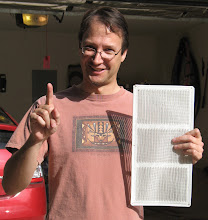
It was now the spring of 2007. I had successfully navigated the early waters of what amounted to the early low-hanging fruit of energy efficiency in my house:
1) Ductwork leaking conditioned air into the attic
2) Soffit vents blocked for many years by insulation
3) Insufficient and badly placed attic vents
Our electric utility company keeps online records of customers' electric usage by month. Using their numbers, I have been able to quantify my electric usage changes. Note that this is not a perfect analysis; for example, it does not take into account the fact that one summer does not have the exact same weather as the next. A fair disclaimer: the summer of 2007 was a cooler and cloudier one than 2006, the last summer before I made the improvements. Actually, the improvements started in 2006, so I will compare to 2005 readings. Nevertheless, the only data I have to compare are the utility readings, so here are the numbers:
Electric usage in 2005: 14,000 kWH
Electric usage in 2007: 8,000 kWH
In other words, the improvements had yielded at most a 44% improvement in my yearlong energy use, as best I can measure. The number may be somewhat less due to the unusually "cool" summer of 2007.
In addition to improving my energy efficiency quantified above, these few improvements had the following benefits:
A) Healthier air in the house. The leaky ductwork not only allowed inside air into the attic. By connecting the two airspaces, it must also have allowed attic air into the house. Attic air is chock full of dust, fiberglass fibers, mold spores (largely present due to #2 above) - this is why we wear masks when we work up there. Sealing those ducts has made the residents of the house healthier.
B) An attic less conducive to mold growth. The moldiest areas of the attic that I found were at the back of the house, where the soffit vents had been blocked since the house's construction. Increased airflow will keep moisture from being trapped and condensing in the attic, which will greatly slow the growth of mold.
C) The garage is noticeably cooler when I leave in the morning, and return in the afternoon. This just makes it a less unpleasant place to be when I have to be in there.
So was it worth it? I would have to say that I would not be Energy Efficiency Man if I felt that it were not. Although I started these projects from a standpoint of energy efficiency, as I learned more about the other benefits of my efforts, I becamse excited about them as well. Is there anything wrong with wanting to breathe air that isn't shared with fiberglass insulation? Is there something wrong with wanting to not reside under the world's largest urban mold colony, or not wanting to break a sweat when walking 8 feet to your car in the garage? No, indeed, gentle reader, but for the present, we will return to Energy Efficiency. (We will explore financial worthwhility in the next post).
For as great as progress was in 2007, I had whet my teeth on the gristly but chewable edge of making a single family dwelling energy efficient, and still I hungered. I had stuck my toes into the cool waters of a new way of thinking, and in my Web travels seen the obscure edges of such exotic concepts as reflective radiant barriers and R-values of materials. I longed to experiment with these concepts, with their efficient and (near and dear to my heart) low maintenance possibilities.
So follow me, gentle Reader, as I proceed into the next level of Energy Efficiency, for we have yet a ways to travel, more to learn, and Energy Efficiency to gain.


No comments:
Post a Comment